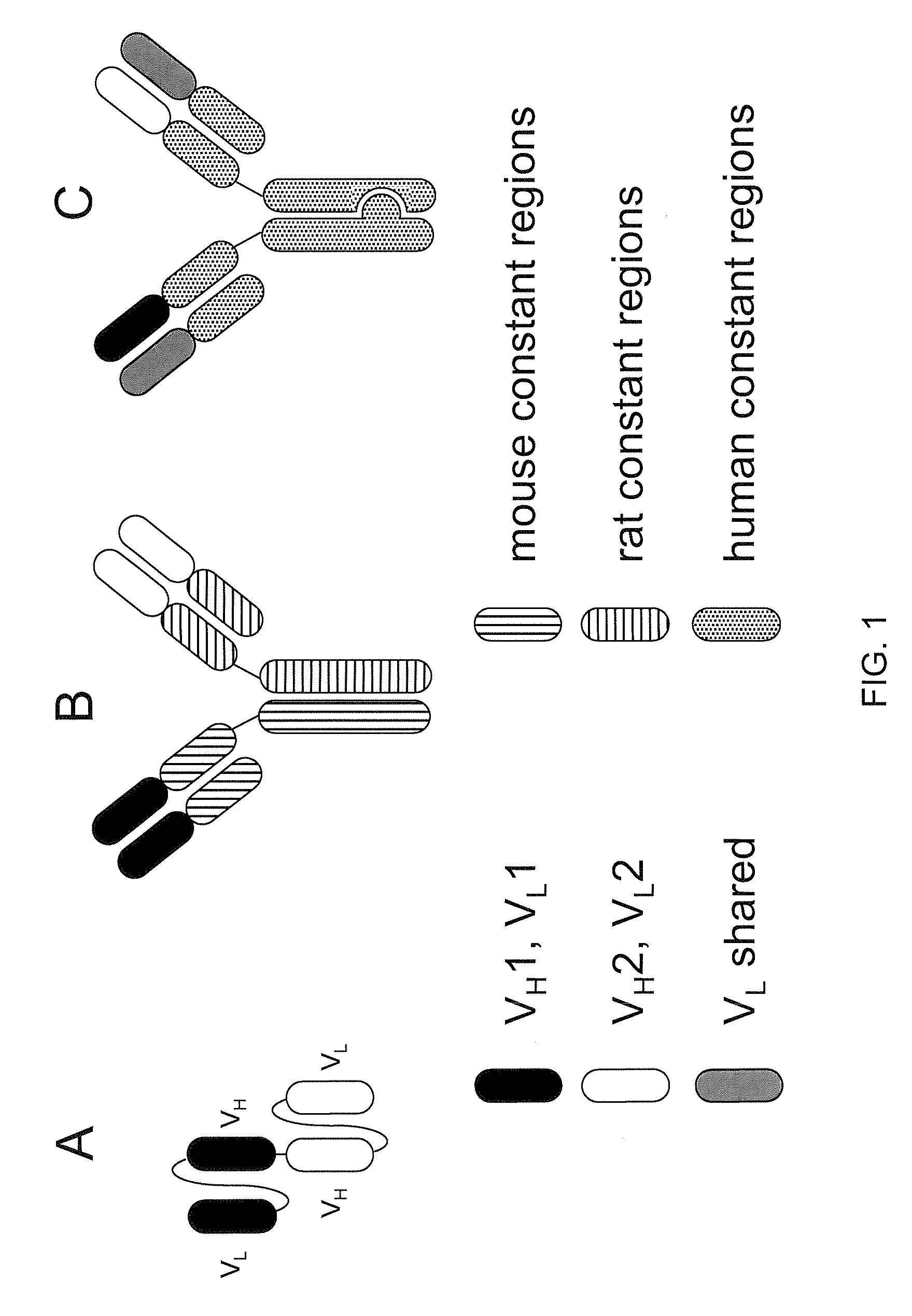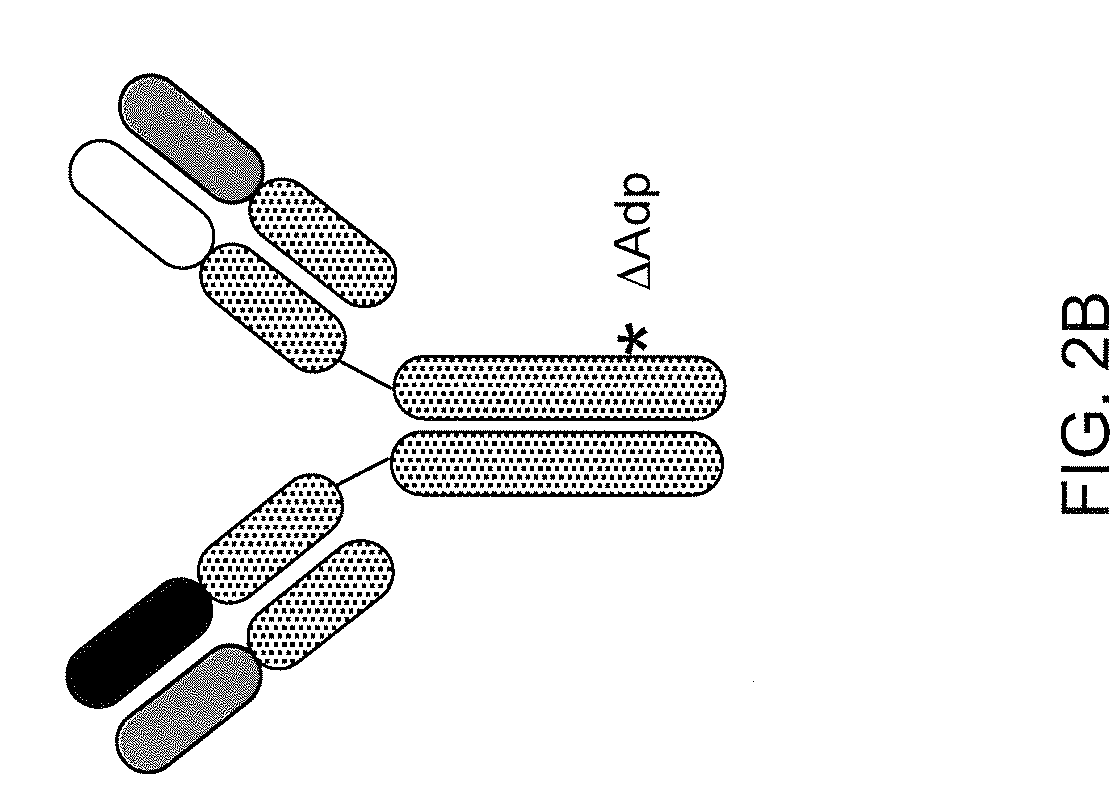Readily Isolated Bispecific Antibodies with Native Immunoglobulin Format
a technology of native immunoglobulin and bispecific antibodies, which is applied in the field of antigen-binding proteins or antibodies having heterodimers of heavy chains, can solve the problems of scfv molecules notorious for their tendency to aggregate, light and heavy chains may not pair well, and can not be easily isolated, so as to reduce or eliminate the binding of the second ch3 domain. , the effect of improving the ability to isolate the protein
- Summary
- Abstract
- Description
- Claims
- Application Information
AI Technical Summary
Benefits of technology
Problems solved by technology
Method used
Image
Examples
example 1
Bispecific IL-4Ra / IL-6Ra Antigen-Binding Protein
[0151]It was found that two known antibodies of human IgG1 isotype, one against IL-4Ra and one against IL-6Ra, had light chains that differed by only four amino acids. Co-expression experiments revealed that the light chain of the anti-IL-4Ra antibody could be replaced with the light chain from the IL-6Ra and still maintain high affinity binding to IL-4Ra, thus making it feasible to produce a bispecific antibody using the anti-IL-4Ra heavy chain and the anti-IL-6Ra heavy chain and the same light chain. Accordingly, the heavy chain of the IL-6Ra antibody was modified to the FcΔAdp form (i.e., CH3 dipeptide modification H95R / Y96F, by IMGT exon numbering).
[0152]The anti-IL-6Ra light chain was then co-expressed with the anti-IL4Ra / Fc and anti-IL6Ra / FcΔAdp heavy chains in CHO cells, and conditioned medium from these cells was subjected to Protein A chromatography. After loading the Protein A column with cell supernatants containing a mixtur...
example 2
Pharmacokinetics of FcΔAdp Proteins
[0153]To test whether the FcΔAdp modification affected the pharmacokinetics of a heterodimeric Fc / FcΔAdp containing molecule, mice were injected with the purified heterodimeric species of anti-IL-4Ra / anti-IL-6Ra described above, and concentrations of human immunoglobulin in serum were measured over a period of 28 days (FIG. 6; Table 1). The serum half-life of the heterodimer was about 10 days, similar to that of the wild type. This establishes that the FcΔAdp modifications had no detectable effect on serum half-life.
TABLE 1Pharmacokinetics (n = 5)Tested Half-life(Days)Drug(avg. ± s.d.)IL-6RΔ / IL-4R11.2 ± 1.8IL-6RΔ / IL-6RΔ10.8 ± 1.9IL-4R / IL-4R10.8 ± 1.9Control11.2 ± 1.9
example 3
Bispecific CD20 / CD3 Antigen-Binding Protein
[0154]It was found that the heavy chain of a known anti-human CD20 antibody, when co-expressed with the light chain of a known (activating) anti-human CD3 antibody, was still able to bind CD20. The anti-CD3 light chain was then co-expressed with either the anti-CD20 / Fc heavy chain, the anti-CD3 / FcΔAdp heavy chain, or both heavy chains. The resulting mixed population of homo- and heterodimers was then used in a bioassay to determine ability to kill CD20 expressing target cells (FIG. 7). Briefly, 2×107 human PBMC cells were activated with 6×107 CD3xCD28 beads (Invitrogen) for 72 hours. Thirty units of IL-2 (R & D Systems) was then added and the cells were incubated for an additional 24 hours. The cells were then split to a concentration of 0.5×106 / mL and an additional 30 U IL-2 added. The cells were then incubated an additional 48 hours and used in the bioassay. On the day of the bioassay 2×106 / mL CD20 expressing target cells (Raji) were labe...
PUM
| Property | Measurement | Unit |
|---|---|---|
| pH | aaaaa | aaaaa |
| pH | aaaaa | aaaaa |
| pH | aaaaa | aaaaa |
Abstract
Description
Claims
Application Information
 Login to View More
Login to View More - R&D
- Intellectual Property
- Life Sciences
- Materials
- Tech Scout
- Unparalleled Data Quality
- Higher Quality Content
- 60% Fewer Hallucinations
Browse by: Latest US Patents, China's latest patents, Technical Efficacy Thesaurus, Application Domain, Technology Topic, Popular Technical Reports.
© 2025 PatSnap. All rights reserved.Legal|Privacy policy|Modern Slavery Act Transparency Statement|Sitemap|About US| Contact US: help@patsnap.com



